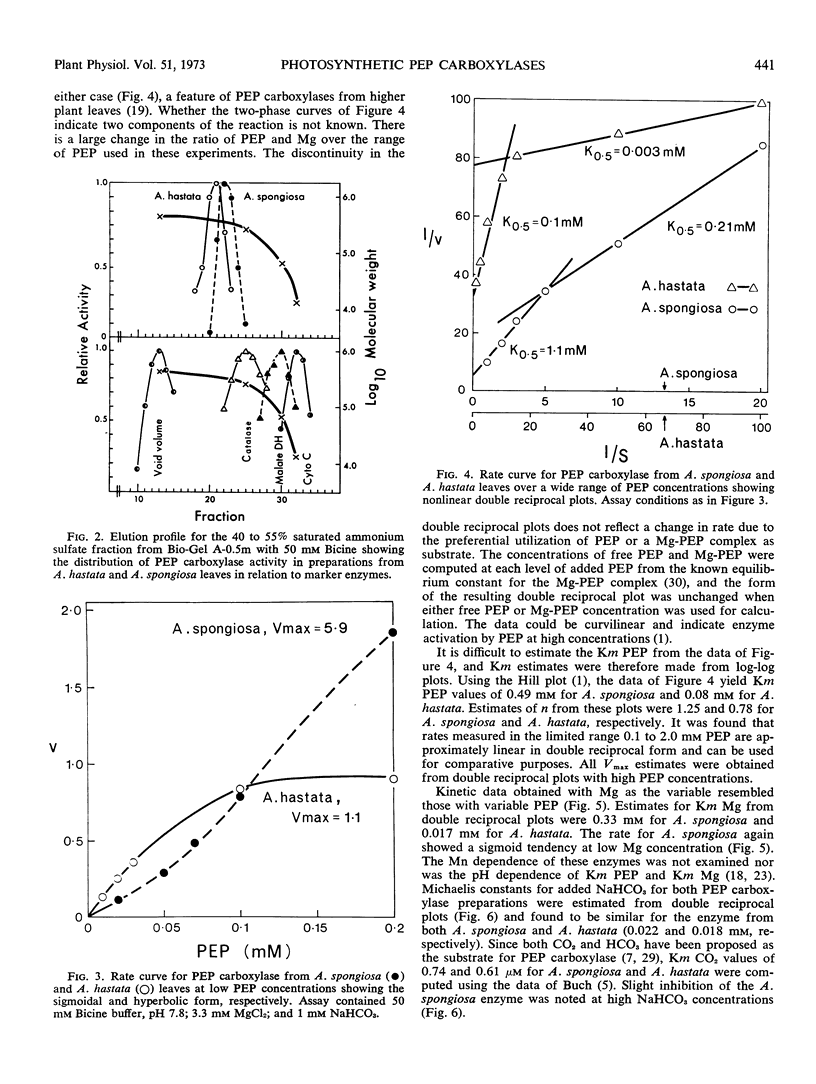Abstract
A detailed comparison of green leaf phosphoenolpyruvate carboxylases from the C4-species Atriplex spongiosa and the C3-species Atriplex hastata revealed significant physical and kinetic differences. The two alloenzymes can be separated by anion exchange chromatography but have comparable molecular weights (350,000). Maximal velocity estimates were 38.0 and 1.48 micromoles per minute per milligram of chlorophyll for the carboxylases of A. spongiosa and A. hastata, respectively. Km phosphoenolpyruvate estimates were 0.49 and 0.08 mm for the C4A. spongiosa and C3A. hastata and the Km Mg estimates were 0.33 mm for the C4 species and 0.017 mm for the C3 species. The activity of the phosphoenolpyruvate carboxylase of A. spongiosa is more sensitive to chloride and phosphate than the phosphoenolpyruvate carboxylase of A. hastata, but both are equally sensitive to Mg chelating substances such as ATP, ADP, and citrate if assayed at their respective Km Mg values. A survey of the phosphoenolpyruvate carboxylases from 18 C4 and C3 species resulted in mean maximal velocity estimates of 29.0 ± 13.2 and 1.50 ± 0.57 micromoles per minute per milligram of chlorophyll for the C4 species and C3 species, respectively. Km phosphoenolpyruvate estimates were 0.59 ± 0.35 mm and 0.14 ± 0.07 mm for the C4 and C3, and Km Mg estimates were 0.50 ± 0.30 and 0.097 ± 0.057 mm for C4 and C3. All differences between means were significant at the 0.01 confidence level, supporting our hypothesis that the phosphoenolpyruvate carboxylase alloenzymes of C4 and C3 plants are functionally different and are associated with different photosynthetic roles. Both function in the photosynthetic production of C4 acids, the phosphoenolpyruvate carboxylase of C4 species largely producing malate or aspartate (or both) as a photosynthetic intermediate and the phosphoenolpyruvate carboxylase of C3 species producing malate or aspartate (or both) as a photosynthetic product.
Full text
PDF








Selected References
These references are in PubMed. This may not be the complete list of references from this article.
- BASSHAM J. A., BENSON A. A., CALVIN M. The path of carbon in photosynthesis. J Biol Chem. 1950 Aug;185(2):781–787. [PubMed] [Google Scholar]
- Cooper T. G., Wood H. G. The carboxylation of phosphoenolpyruvate and pyruvate. II. The active species of "CO2" utilized by phosphoenlpyruvate carboxylase and pyruvate carboxylase. J Biol Chem. 1971 Sep 10;246(17):5488–5490. [PubMed] [Google Scholar]
- Corwin L. M., Fanning G. R. Studies of parameters affecting the allosteric nature of phosphoenolpyruvate carboxylase of Escherichia coli. J Biol Chem. 1968 Jun 25;243(12):3517–3525. [PubMed] [Google Scholar]
- Cánovas J. L., Kornberg H. L. Properties and regulation of phosphopyruvate carboxylase activity in Escherichia coli. Proc R Soc Lond B Biol Sci. 1966 Aug 16;165(999):189–205. doi: 10.1098/rspb.1966.0064. [DOI] [PubMed] [Google Scholar]
- Hatch M. D., Slack C. R. Studies on the mechanism of activation and inactivation of pyruvate, phosphate dikinase. A possible regulatory role for the enzyme in the C4 dicarboxylic acid pathway of photosynthesis. Biochem J. 1969 May;112(5):549–558. doi: 10.1042/bj1120549. [DOI] [PMC free article] [PubMed] [Google Scholar]
- Izui K., Yoshinaga T., Morikawa M., Katsuki H. Activation of phosphoenolpyruvate carboxylase of Escherichia coli by free fatty acids or their coenzyme A derivatives. Biochem Biophys Res Commun. 1970 Aug 24;40(4):949–956. doi: 10.1016/0006-291x(70)90995-2. [DOI] [PubMed] [Google Scholar]
- Lowe J., Slack C. R. Inhibition of maize leaf phosphopyruvate carboxylase by oxaloacetate. Biochim Biophys Acta. 1971 Apr 14;235(1):207–209. doi: 10.1016/0005-2744(71)90048-9. [DOI] [PubMed] [Google Scholar]
- Maeba P., Sanwal B. D. Feedback inhibition of phosphoenolpyruvate carboxylase of Salmonella. Biochem Biophys Res Commun. 1965 Dec 9;21(5):503–508. doi: 10.1016/0006-291x(65)90412-2. [DOI] [PubMed] [Google Scholar]
- Maruyama H., Easterday R. L., Chang H. C., Lane M. D. The enzymatic carboxylation of phosphoenolpyruvate. I. Purification and properties of phosphoenolpyruvate carboxylase. J Biol Chem. 1966 May 25;241(10):2405–2412. [PubMed] [Google Scholar]
- Nishikido T., Izui K., Iwatani A., Katsuki H., Tanaka S. Inhibition of the carbon dioxide fixation of E. coli by the compounds related to TCA cycle. Biochem Biophys Res Commun. 1965 Oct 26;21(2):94–99. doi: 10.1016/0006-291x(65)90092-6. [DOI] [PubMed] [Google Scholar]
- Osmond C. B. Salt responses of carboxylation enzymes from species differing in salt tolerance. Plant Physiol. 1972 Feb;49(2):260–263. doi: 10.1104/pp.49.2.260. [DOI] [PMC free article] [PubMed] [Google Scholar]
- Smith T. E. Partial purification and characteristics of potato phosphoenolpyruvate carboxylase. Arch Biochem Biophys. 1968 Apr;125(1):178–188. doi: 10.1016/0003-9861(68)90653-x. [DOI] [PubMed] [Google Scholar]
- TAKETA K., POGELL B. M. ALLOSTERIC INHIBITION OF RAT LIVER FRUCTOSE 1,6-DIPHOSPHATASE BY ADENOSINE 5'-MONOPHOSPHATE. J Biol Chem. 1965 Feb;240:651–662. [PubMed] [Google Scholar]
- Ting I. P. CO(2) Metabolism in Corn Roots. III. Inhibition of P-enolpyruvate Carboxylase by l-malate. Plant Physiol. 1968 Dec;43(12):1919–1924. doi: 10.1104/pp.43.12.1919. [DOI] [PMC free article] [PubMed] [Google Scholar]
- Ting I. P. Malic dehydrogenases in corn root tips. Arch Biochem Biophys. 1968 Jul;126(1):1–7. doi: 10.1016/0003-9861(68)90552-3. [DOI] [PubMed] [Google Scholar]
- Ting I. P., Osmond C. B. Multiple forms of plant phosphoenolpyruvate carboxylase associated with different metabolic pathways. Plant Physiol. 1973 Mar;51(3):448–453. doi: 10.1104/pp.51.3.448. [DOI] [PMC free article] [PubMed] [Google Scholar]
- WOLD F., BALLOU C. E. Studies on the enzyme enolase. I. Equilibrium studies. J Biol Chem. 1957 Jul;227(1):301–312. [PubMed] [Google Scholar]


